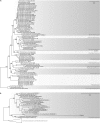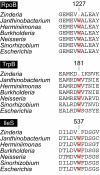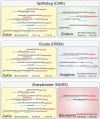Functional convergence in reduced genomes of bacterial symbionts spanning 200 My of evolution
- PMID: 20829280
- PMCID: PMC2953269
- DOI: 10.1093/gbe/evq055
Functional convergence in reduced genomes of bacterial symbionts spanning 200 My of evolution
Abstract
The main genomic changes in the evolution of host-restricted microbial symbionts are ongoing inactivation and loss of genes combined with rapid sequence evolution and extreme structural stability; these changes reflect high levels of genetic drift due to small population sizes and strict clonality. This genomic erosion includes irreversible loss of genes in many functional categories and can include genes that underlie the nutritional contributions to hosts that are the basis of the symbiotic association. Candidatus Sulcia muelleri is an ancient symbiont of sap-feeding insects and is typically coresident with another bacterial symbiont that varies among host subclades. Previously sequenced Sulcia genomes retain pathways for the same eight essential amino acids, whereas coresident symbionts synthesize the remaining two. Here, we describe a dual symbiotic system consisting of Sulcia and a novel species of Betaproteobacteria, Candidatus Zinderia insecticola, both living in the spittlebug Clastoptera arizonana. This Sulcia has completely lost the pathway for the biosynthesis of tryptophan and, therefore, retains the ability to make only 7 of the 10 essential amino acids. Zinderia has a tiny genome (208 kb) and the most extreme nucleotide base composition (13.5% G + C) reported to date, yet retains the ability to make the remaining three essential amino acids, perfectly complementing capabilities of the coresident Sulcia. Combined with the results from related symbiotic systems with complete genomes, these data demonstrate the critical role that bacterial symbionts play in the host insect's biology and reveal one outcome following the loss of a critical metabolic activity through genome reduction.
Figures






References
-
- Andersson JO, Andersson SG. Genome degradation is an ongoing process in Rickettsia. Mol Biol Evol. 1999a;16:1178–1191. - PubMed
-
- Andersson JO, Andersson SG. Insights into the evolutionary process of genome degradation. Curr Opin Genet Dev. 1999b;9:664–671. - PubMed
-
- Andersson JO, Andersson SG. Pseudogenes, junk DNA, and the dynamics of Rickettsia genomes. Mol Biol Evol. 2001;18:829–839. - PubMed
-
- Andersson SG, Kurland CG. Reductive evolution of resident genomes. Trends Microbiol. 1998;6:263–268. - PubMed
-
- Andersson SG, et al. The genome sequence of Rickettsia prowazekii and the origin of mitochondria. Nature. 1998;396:133–140. - PubMed
Publication types
MeSH terms
Substances
Associated data
- Actions
- Actions
Grants and funding
LinkOut - more resources
Full Text Sources
Molecular Biology Databases
Miscellaneous

